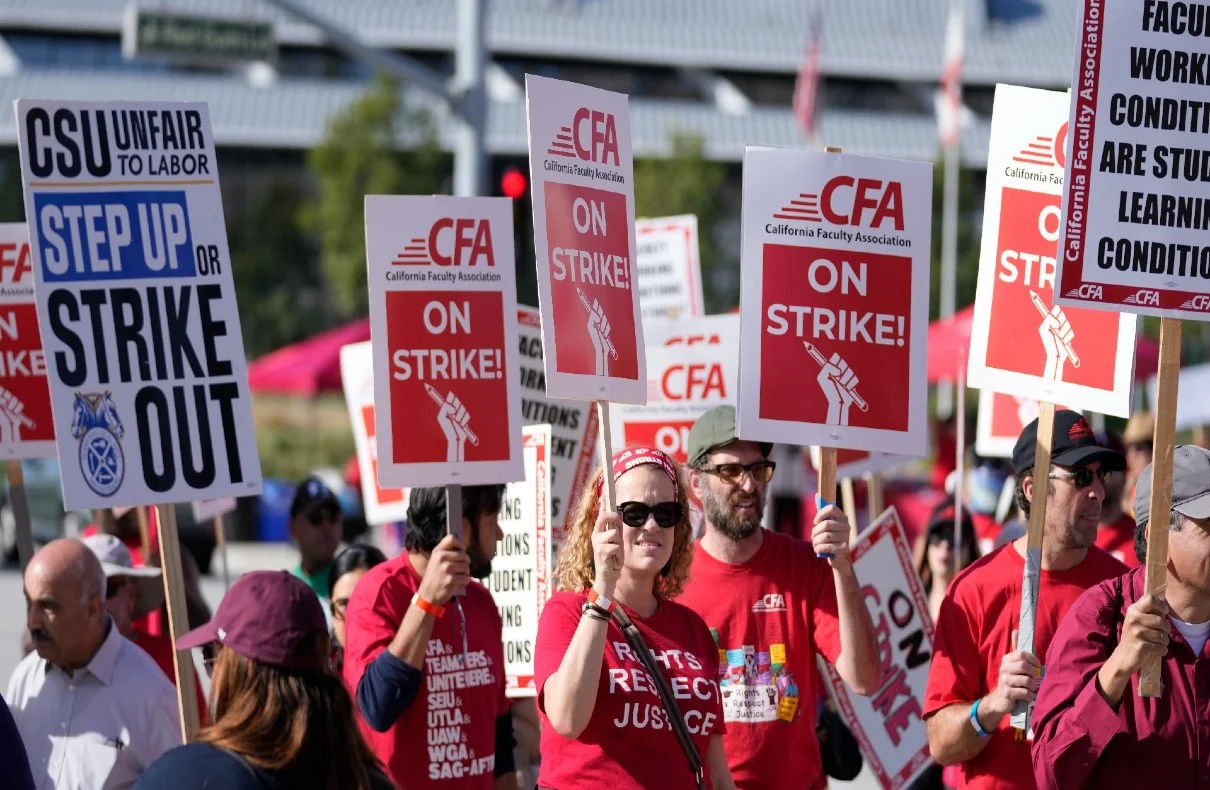
The California State University (CSU) system, comprising 23 campuses and serving nearly 460,000 students, is facing a historic strike as thousands of professors, lecturers, librarians, and other employees walk off the job. The strike, which is set to last for five days, is the largest university faculty strike in U.S. history. The faculty members, represented by the California Faculty Association (CFA), are demanding higher compensation and other workplace improvements.
The CSU faculty union, represented by the CFA, has been engaged in contract negotiations with university officials for several months. The main point of contention is the issue of pay increases. The union is demanding a 12% raise for faculty members, citing the need to combat inflation and improve their standard of living. They argue that many faculty members are struggling to make ends meet, working multiple jobs and facing financial instability.
On the other hand, the university system has offered a 5% general raise, similar to the agreements reached with other unions in the past year. CSU officials contend that they cannot afford the higher pay increase without making significant cuts to programs and services. They argue that the system already spends 75% of its operating budget on staff compensation and must operate within its financial realities to protect the long-term stability and success of the university.
3 University of Wyoming Swimmers Killed in Tragic Car Crash in Colorado
As negotiations reached an impasse, the faculty union escalated its tactics to put pressure on the university system. Last month, faculty members staged one-day strikes at four campuses, including Cal Poly Pomona, San Francisco State University, Cal State Los Angeles, and Sacramento State University. These localized strikes served as a warning and a show of strength from the faculty union.
However, with the university system standing firm on their offer of a 5% pay increase, the faculty union decided to take more drastic action. The planned five-day strike, beginning on the first day of the spring semester, represents a significant escalation of the labor dispute. It is the first time in the history of the CFA that a strike has been organized across all 23 campuses simultaneously.
In addition to the pay increase, the faculty union has put forth a range of demands aimed at improving working conditions for its members. These demands include an increase in the minimum salary for full-time employees, an extension of paid parental leave, and caps on class sizes. The union argues that these changes are necessary to attract and retain quality faculty members and ensure a high standard of education for CSU students.
The strike is expected to significantly disrupt the first week of the spring semester, with most classes being canceled or temporarily moved to online platforms. While the university system has stated that campuses will remain open and students should check with their professors about class schedules during the strike, the majority of faculty members are expected to participate in the walkout.
CSU officials have emphasized the financial challenges they face in meeting the faculty union’s demands. The university system has already revealed that it spends $1.5 billion less than needed to adequately educate its students. To address this budget shortfall, the CSU Board of Trustees approved 6% annual tuition increases over five years, a decision that was met with opposition from the faculty union.
The university system argues that agreeing to the higher pay increase demanded by the faculty union would require severe cuts to programs and services, potentially jeopardizing the educational mission of CSU. They contend that they must operate within their financial realities and make fiscally prudent decisions to ensure the long-term stability and success of the university.
The strike has elicited mixed reactions from CSU students. While some students express support for their faculty members’ demands and believe their voices should be heard, others are concerned about the potential disruption to their education. The strike comes at a crucial time when students are typically making last-minute adjustments to their schedules and professors are outlining class expectations.
Many students are unsure of the status of their classes during the strike. Some faculty members have canceled classes for the entire week, while others have chosen to continue teaching. The university system has encouraged students to communicate with their professors to determine the status of their classes during this period of labor action.
College Student Arrested After Teen Found Dead in Campbellsville University Dorm Room Case
Chancellor Mildred Garcia, who recently assumed the role, faces a challenging situation as she navigates the strike and the broader issues facing the CSU system. Garcia is recognized for her efforts to improve graduation rates and support Latino students during her tenure as president of Cal State Fullerton. However, she now faces the task of addressing the faculty union’s demands and finding a resolution that balances the needs of faculty members, students, and the financial realities of the university system.
As the strike unfolds, both the faculty union and the university system have expressed their willingness to return to the bargaining table to seek a resolution. The outcome of the strike and the subsequent negotiations will have implications not only for CSU faculty members but also for the broader labor landscape in higher education.
If the two sides fail to reach an agreement, the faculty union may consider other labor actions, such as rolling strikes across different campuses or requesting that faculty members fulfill only the minimum amount of work required. The path forward remains uncertain, but both parties are hopeful that a resolution can be reached to address the faculty union’s concerns while ensuring the long-term success of the CSU system.
